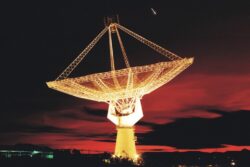One of the dishes of the Giant Metrewave Radio Telescope (GMRT) near Pune, Maharashtra, India (Picture: National Centre for Radio Astrophysics)
Scientists have captured a special kind of radio signal from a galaxy that’s nearly 9 billion light-years away from the Earth.
Before you jump to conclusions, the signal was not sent by aliens but was emitted from a star-forming galaxy called ‘SDSSJ0826+5630’, when the universe was only 4.9 billion years old.
What makes this radio signal special is that it’s at a specific wavelength known as the ’21 cm line’.
Meaning, it could allow astronomers to peer into the secrets of the early universe.
‘It’s the equivalent to a look-back in time of 8.8 billion years,’ said Arnab Chakraborty, a cosmologist and co-author of a study on the detection.
This is the first time this type of radio signal has been detected at such a massive distance.
Illustration showing detection of the signal from a distant galaxy (Picture: Swadha Pardesi)
‘A galaxy emits different kinds of radio signals. Until now, it’s only been possible to capture this particular signal from a galaxy nearby, limiting our knowledge to those galaxies closer to Earth,’ said Chakraborty.
Researchers from Montreal and India were able to capture the signals with the help of a Giant Metrewave Radio Telescope in India.
The discovery was announced this week in the Monthly Notices of the Royal Astronomical Society journal.
The faint signal was captured from a record-breaking distance thanks to the help of a naturally occurring phenomenon called gravitational lensing.
‘Gravitational lensing magnifies the signal coming from a distant object to help us peer into the early universe,’ said co-author Nirupam Roy.
Image of the radio signal from the galaxy (Picture: Chakraborty & Roy/NCRA-TIFR/GMRT)
In this case, the signal was bent by the presence of another galaxy and magnified, allowing the telescope to pick it up.
Using the signal, the researchers were already able to measure the gas composition of the distant galaxy it was coming from.
The researchers found that the atomic mass of the gas content of this particular galaxy is almost twice the mass of the stars visible to us.
So, while aliens might not have contacted the Earth, the discovery still up new opportunities for probing the cosmic evolution of stars and galaxies with low-frequency radio telescopes.
What is the ’21 cm line’?
In astronomy, the 21 centimetre line also known as the hydrogen line, is the electromagnetic radiation spectral line with a frequency of 1420.
Because hydrogen is spread out across our universe, it’s a great way to map-out the location of galaxies. So, astronomers use radio telescopes to pick up 21-cm line wavelength signals to try and map the universe.
MORE : James Webb Space Telescope spots first alien planet – and it’s similar to Earth
MORE : Aliens haven’t contacted Earth because ‘there’s no intelligent life here’, scientist says
No, they were not sent by aliens.





